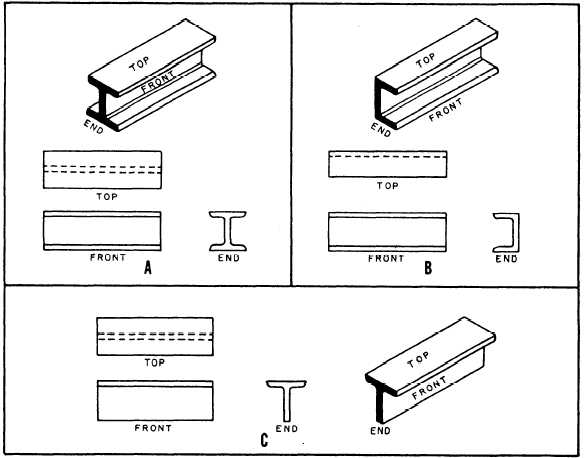BEARING PILES—A bearing pile is the same as a
wide-flange or H-beam, but is much heavier per linear
foot. Therefore, the dimension 14-inch (nominal depth)
bearing pile weighs 73 pounds per linear foot. Note that
this beam weighs nearly as much as the 24-inch
wide-flange shape mentioned earlier.
ZEE—These shapes are noted by depth, flange
width, and weight per linear foot. Therefore, Z 6 x 3 1/2
x 15.7 means the zee is 6 inches in depth, has a 3 1/2-inch
flange, and weighs 15.7 pounds per linear foot.
PLATES—Plates are noted by width, thickness,
and length. Therefore, PI 18 x 1/2 x 2´-6" means the
plate is 18 inches wide, 1/2 inch thick, and 2 feet 6
inches long.
FLAT BAR—This shape is a plate with a width less
than 6 inches and a thickness greater than 3/16 inch.
Bars usually have their edges rolled square. The
dimensions are given for width and thickness.
Therefore, 2 1/2 x 1/4 means that the bar is 2 1/2 inches
wide and 1/4 inch thick
TIE ROD AND PIPE COLUMN—Tie rods and
pipe columns are designated by their outside diameters.
Therefore, 3/4
f
TR means a tie rod with a diameter of
3/4 inch. The dimension 6
f,
indicates a 6-inch
diameter pipe. Figure 7-2 illustrates the methods
whereby three of the more common types of structural
shapes just described are projected on a drawing print.
MEMBERS
The main parts of a structure are the load-bearing
structural members that support and transfer the loads
on the structure while remaining in equilibrium with
each other. The places where members are connected
to other members are called joints. The total load
supported by the structural members at a particular
instant is equal to the total dead load plus the total live
load.
The total dead load is the total weight of the
structure, which gradually increases as the structure
rises and remains constant once it is completed. The
total live load is the total weight of movable objects,
such as people, furniture, and bridge traffic, that the
Figure 7-2.—Projecting structural shapes. A. I- or H-beam. B. Channel. C. Tee.
7-3


